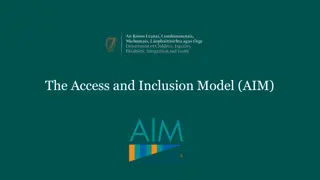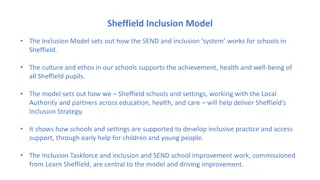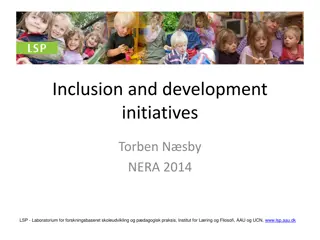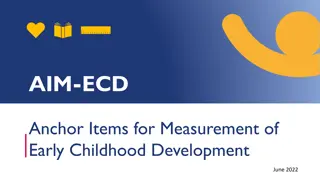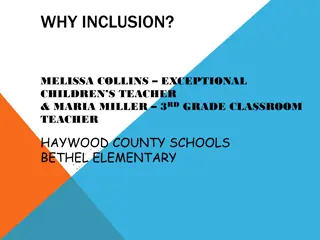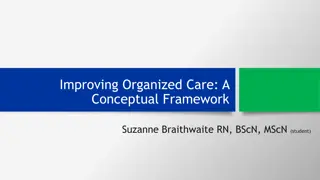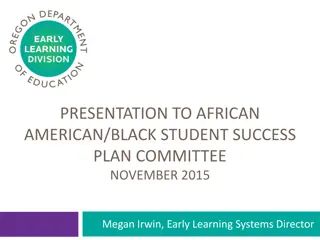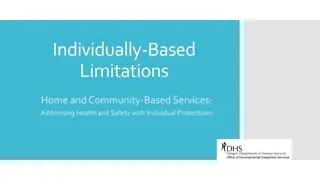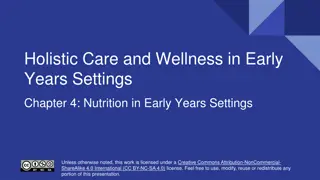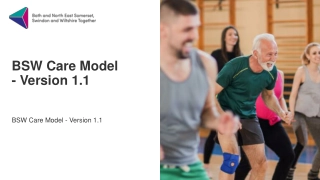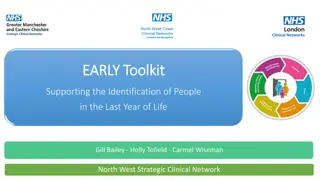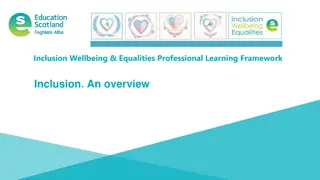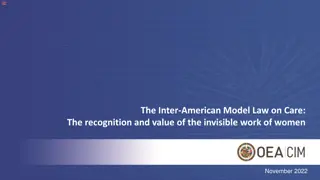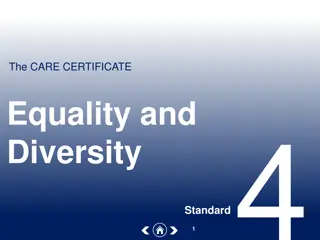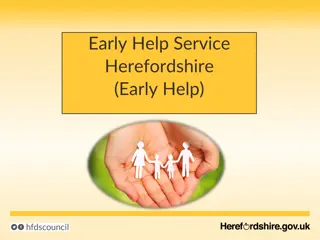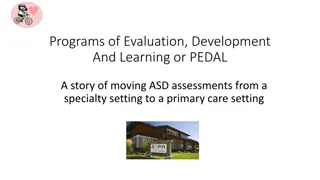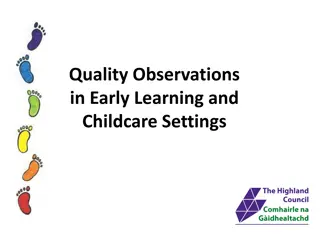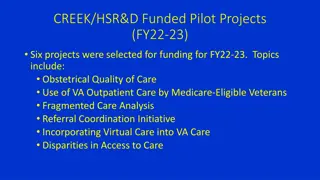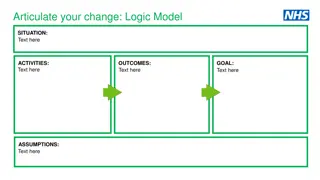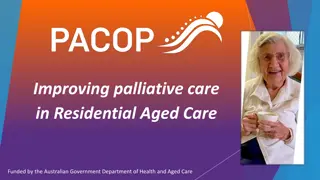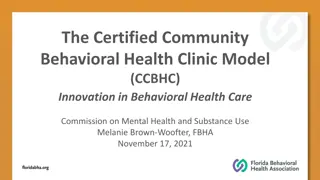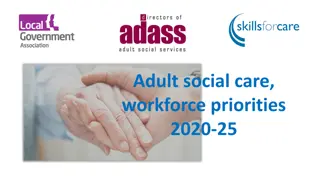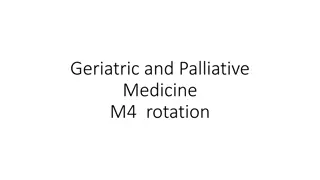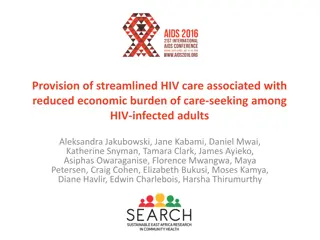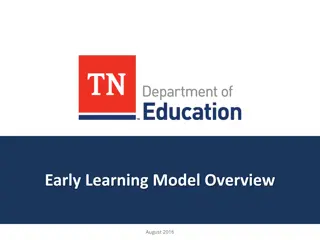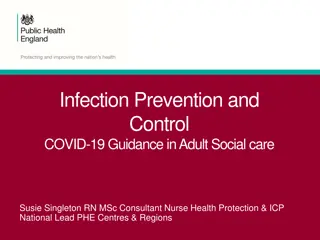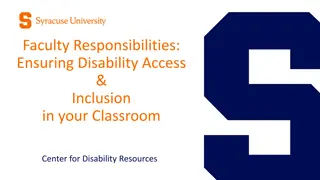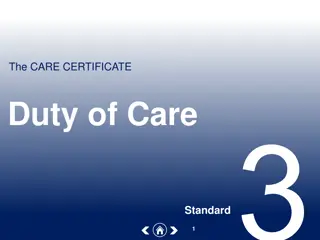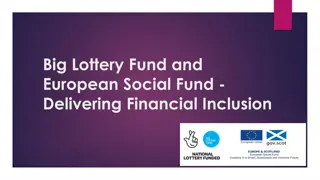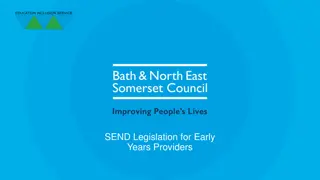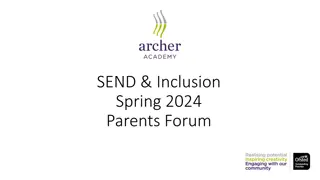The Access and Inclusion Model (AIM) - Supporting Inclusion in Early Learning and Care Settings
The Access and Inclusion Model (AIM) provides a suite of supports for children and staff in Early Learning and Care settings, founded by the Department of Children, Equality, Disability, Integration and Youth (DCEDIY) in 2016. AIM aims to create a more inclusive environment so that all children, regardless of ability, can benefit from quality early years care and education. The supports offered by AIM are categorized into Universal Support (Levels 1-3) and Targeted Support (Levels 4-7) focusing on creating a more inclusive culture and addressing the needs of each child.
Download Presentation

Please find below an Image/Link to download the presentation.
The content on the website is provided AS IS for your information and personal use only. It may not be sold, licensed, or shared on other websites without obtaining consent from the author. Download presentation by click this link. If you encounter any issues during the download, it is possible that the publisher has removed the file from their server.
E N D
Presentation Transcript
The Access and Inclusion Model (AIM) Matthew Day, AIM Team, DCEDIY
The Access and Inclusion Model (AIM) Introduction AIM is a suite of supports for both children and staff in Early Learning and Care settings. AIM was founded in 2016 by the Department of Children, Equality, Disability, Integration and Youth (DCEDIY). The goal of AIM is to create a more inclusive environment in Early Learning and Care settings, so that all children, regardless of ability, can benefit from quality early years care and education. 05/02/21 AIM TEAM- DCEDIY 2
The Access and Inclusion Model (AIM) Background Free pre-school was introduced under the ECCE programme was introduced in 2010. The AIM programme was proposed by an Interdepartmental Group to allow children with disabilities to participate in the ECCE Programme. The model was founded by DCEDIY, DES and DoH and is administered by Pobal and Better Start. The model was launched by the Government in June 2016 and rolled-out from September 2016. 05/02/21 AIM TEAM- DCEDIY 3
The Access and Inclusion Model (AIM) What Supports are Offered as part of AIM? AIM supports are divided into two catagories: Universal Supports (Levels 1-3) benefit the whole pre-school environment through empowering pre- school providers to create a more inclusive culture in their settings. Targeted Supports (Levels 4-7) cater to a wide range of abilities and are focused on the needs of the child and do not need a diagnosis of disability. 05/02/21 AIM TEAM- DCEDIY 4
The Access and Inclusion Model (AIM) Level 1: Supporting Inclusion Inclusion Coordinator Training (LINC) The Leadership for Inclusion in Early Years Care (LINC) is a qualification for early years educators. With this qualification, pre-school staff can become an Inclusion Coordinator (INCO) in a pre-school setting. Where a service provider is, or employs a fully qualified Inclusion Co-ordinator in their pre- school setting, that provider will qualify for an increase of 2 per child per week in ECCE capitation. 05/02/21 AIM TEAM- DCEDIY 5
The Access and Inclusion Model (AIM) Level 1: Supporting Inclusion Equality Diversity and Inclusion (EDI) The Equality, Diversity and Inclusion Charter was developed by DCEDIY to empower pre- school staff to develop inclusive practices in their settings. EDI training helps providers; understand the EDI charter and guidelines and create their own inclusion charter for their setting. These courses are free of charge and available nationwide. 05/02/21 AIM TEAM- DCEDIY 6
The Access and Inclusion Model (AIM) Level 2: Information for Parents and Providers AIM Level 2 is the provision of accurate and up to date information about AIM for parents and providers. The AIM website, www.aim.gov.ie is the core of AIM level 2, providing information on AIM supports, how to apply, organisations linked to AIM and information on inclusion and disability as a whole. 05/02/21 AIM TEAM- DCEDIY 7
The Access and Inclusion Model (AIM) Level 3: Training and Education for the workforce AIM supports Early Learning and Care settings by providing three Continuing Professional Development (CPD) courses in the areas of disability and inclusion, these are: Hanen- A training course to help providers enable young children to develop language and literacy skills. L mh- A manual sign language system used by children and adults with intellectual disability and communication needs. SPEL- SPEL stands for Sensory Processing E-Learning programme and helps providers support children with sensory processing difficulties. 05/02/21 AIM TEAM- DCEDIY 8
The Access and Inclusion Model (AIM) Level 4: Access to Early Years Specialists AIM level 4 is delivered by the Better Start Early Years Specialist Service (EYSS). The EYSS work collaboratively with parents, pre- school providers, and with other professionals to develop inclusive learning environments in pre-schools. The EYSS also provides coaching and mentoring to the pre-school staff on supporting children in the ECCE programme. The EYSS can also act as a liaison with the National Council for Special Education to support transitions to primary school. 05/02/21 AIM TEAM- DCEDIY 9
The Access and Inclusion Model (AIM) Level 5: Specialised Equipment, Appliances and Minor Alterations Under level 5, AIM can provide specialised equipment, appliances or capital grants towards minor building alterations to ensure a child s meaningful participation in pre-school. Level 5 support can include a hoist, hearing aid or wheelchair ramp to name a few examples. Training in the use of equipment will be given to providers free of charge. 05/02/21 AIM TEAM- DCEDIY 10
The Access and Inclusion Model (AIM) Level 6: Therapeutic Supports AIM provides a range of services in collaboration with the HSE under therapeutic supports. These services include; behaviour support plans, classes, equipment, professional advice or pre-school visits. Supports may be provided through a Children s Disability Network Team (CDNT), HSE Disability Service, HSE funded Voluntary Organisation or HSE Primary Care Services. 05/02/21 AIM TEAM- DCEDIY 11
The Access and Inclusion Model (AIM) Level 7: Additional Assistance AIM level 7 support provides additional funding to pre-schools who have a child requiring extra support. Providers can use this funding either to reduce the child-to-adult ratio in the pre- school room or to fund an extra staff member as a shared resource with other children in the ECCE setting. A simple reduction in the staff to child ratio can have hugely positive outcomes for children with disabilities as well as for the entire pre-school room. 05/02/21 AIM TEAM- DCEDIY 12


